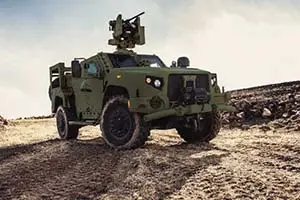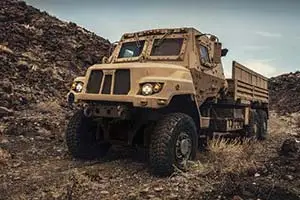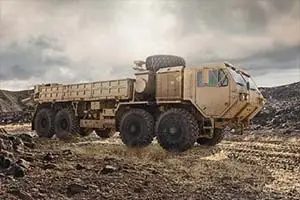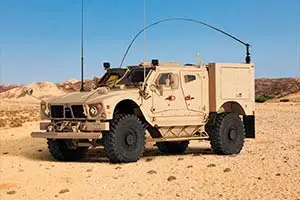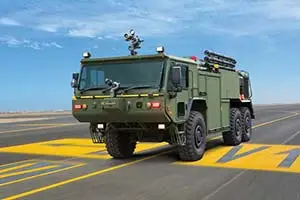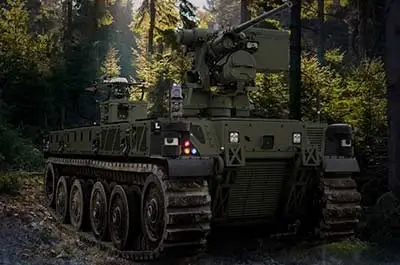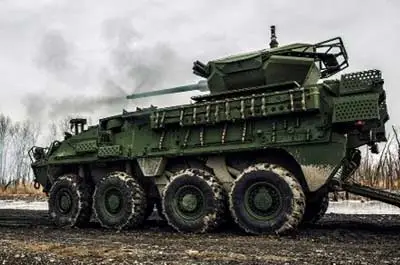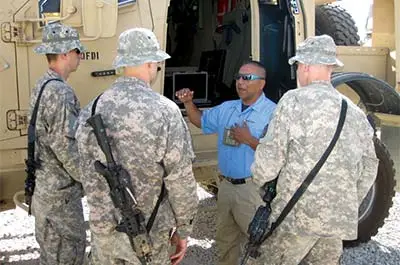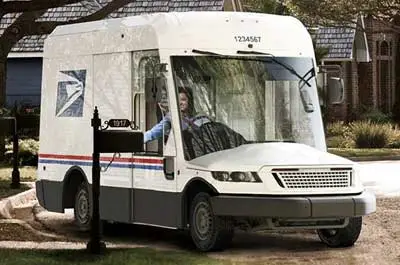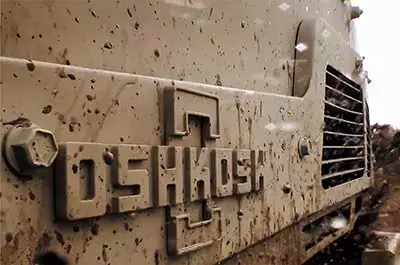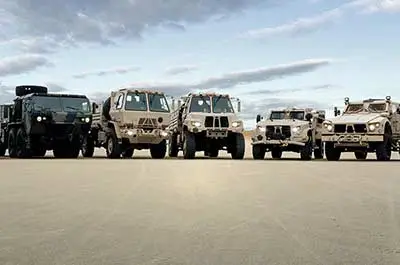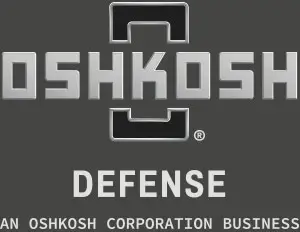OSHKOSH, Wis. (Oct. 10, 2005) – Oshkosh Truck Corporation [NYSE: OSK] and partners Rockwell Collins [NYSE: COL] and the University of Parma, Italy, announced that their robotic truck, TerraMax™, has completed the DARPA Grand Challenge. The vehicle was one of five to complete the race.
TerraMax completed the 132-mile desert course with an unofficial run time of 12 hours and 51 minutes. The team was assigned a starting time more than two hours behind the first vehicle, and was “paused” numerous times by DARPA officials to accommodate disabled or slower moving vehicles on the course. As a result, daylight ended before TerraMax could complete the course on the first day. Even though TerraMax was capable of operating autonomously in the dark, race officials paused it in the middle of the desert — among snakes, scorpions and coyotes — until daybreak for the safety of the chase vehicle drivers.
TerraMax idled in the desert overnight, setting off for the finish line at dawn. About five miles from the course’s end, this eight-foot-wide defense truck passed through Beer Bottle Pass, with just inches to spare between its bumper and a 200-foot sheer cliff. TerraMax was the largest and widest vehicle to successfully navigate this narrow, treacherous mountain road, demonstrating the precision of the vehicle’s numerous sensing systems. The large Oshkosh truck crossed the finish line just after noon on Sunday, October 9, following more than 30 hours of continuous operation.
“This was a remarkable day for Team TerraMax, for our nation’s military, and for the history books,” said Robert G. Bohn, Oshkosh Truck chairman, president and chief executive officer. “DARPA’s goal is to help take our troops out of harm’s way by fostering development of unmanned vehicles. Completing the race spectacularly indicates how close we may be to making this a reality.”
“The development program associated with completing the Grand Challenge was rewarding in and of itself,” said Don Verhoff, Oshkosh executive vice president of corporate engineering and technology. “We gained immense knowledge regarding autonomous vehicle technologies that are viable in the rigorous military environment, and we are committed to moving this technology forward to aid the men and women of the U.S. military. That’s what this is all about and completing the Grand Challenge was the first milestone.”
TerraMax’s autonomous systems were optimized for a more difficult environment than it faced on the racecourse selected by DARPA.
“We decided in the beginning that we would design this vehicle to autonomously handle real off-road terrain, actively detect and navigate around obstacles, and maintain a high-level of confidence in vehicle safety,” said Scott Uhlir, Rockwell Collins principal program manager for advanced programs. “While our race time could have been improved significantly by altering these parameters, we finished the race believing that we are that much closer to providing a real-world solution.”
Three years ago the Defense Advanced Research Projects Agency (DARPA), the research and development arm of the Pentagon, challenged robotics experts from across the country to develop an autonomous, driverless vehicle that could traverse a rugged, off-road desert course. After no vehicle completed last year’s 150-mile DARPA Grand Challenge, 195 teams entered the competition this year. Three levels of qualifying events narrowed the final field to 23.
DARPA Grand Challenge teams were given the race route just two hours before the start of the race at 6:30 a.m. PDT on Saturday, Oct. 8. Team TerraMax members then programmed the course coordinates into their vehicle.
TerraMax is a MTVR (Medium Tactical Vehicle Replacement) that Oshkosh Truck designed for the U.S. Marine Corps. It has a 15-ton on-road and 7.1-ton off-road payload capacity. The MTVR is a 6×6 cargo hauler with Oshkosh Truck’s patented TAK-4® independent suspension system to accommodate its 70 percent off-road profile, ideal for terrain similar to the DARPA Grand Challenge course. There are more than 6,000 Oshkosh MTVRs deployed with the U.S. Marine Corps, and more than 1,500 operating in the Iraq conflict.
TerraMax’s navigational systems were designed and integrated by Rockwell Collins and enhanced with a stereo vision navigation system developed by the Vision Labs at the University of Parma.
In addition to Oshkosh Truck, Rockwell Collins and the University of Parma, Team TerraMax sponsors include ArvinMeritor, Fastenal, Oxford Technologies, Parker Hannifin, Ricoh, Landstar, Michelin, MCL Industries, TransPro, Cat and others. For more information, go to www.terramax.com.
About Rockwell Collins
Rockwell Collins (NYSE: COL) is a worldwide leader in the design, production, and support of communication and aviation electronics for commercial and government customers. The company’s 17,000 employees in 27 countries deliver industry-leading communication, navigation, surveillance, display, flight control, in-flight entertainment, information management, maintenance, training and simulation solutions. Additional information is available at www.rockwellcollins.com.
About the University of Parma, Italy
The University of Parma, Italy, is an experienced developer of synthetic vision systems for the automobile industry. Additional information is available at vislab.ce.unipr.it
About Oshkosh Truck Corporation
Oshkosh Truck Corporation is a leading manufacturer of specialty trucks and truck bodies for the defense, fire and emergency, concrete placement and refuse hauling markets. Oshkosh Truck is a Fortune 1000 company with products marketed under the Oshkosh®, Pierce®, McNeilus®, Medtec™, Geesink, Norba, Jerr-Dan®, CON-E-CO® and London® brand names. The company is headquartered in Oshkosh, Wis., and had annual sales of $2.26 billion in fiscal 2004.
To learn more about Oshkosh Truck Corporation, visit its web site at www.oshkoshtruckcorporation.com.
Forward-Looking Statements
This press release contains statements that the company believes are “forward-looking statements” within the meaning of the U.S. Private Securities Litigation Reform Act of 1995. All statements other than statements of historical fact, including statements regarding the company’s future financial position, business strategy, targets, projected sales, costs, earnings, capital spending and debt levels, and plans and objectives of management for future operations, are forward-looking statements. When used in this press release, words such as the company “expects,” “intends,” “estimates,” “anticipates,” or “believes” and similar expressions are generally intended to identify forward-looking statements. These forward-looking statements are not guarantees of future performance and are subject to risks, uncertainties, assumptions and other factors, some of which are beyond the company’s control that could cause actual results to differ materially from those expressed or implied by such forward-looking statements. These factors include, without limitation, risks related to reductions in government expenditures, the uncertainty of government contracts, risks related to the Company’s acquisition strategy including identifying and evaluating acquisition candidates and integrating acquired businesses, and the possibility that expected synergies and other cost savings will not be achieved nor future plans realized. Additional information concerning these and other factors is contained in the company’s filings with the Securities and Exchange Commission.
# # #
